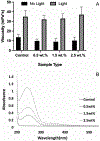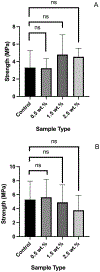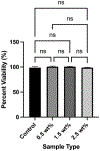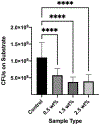Synthesis, characterization and evaluation of azobenzene nanogels for their antibacterial properties in adhesive dentistry
- PMID: 34923692
- PMCID: PMC9122558
- DOI: 10.1111/eos.12832
Synthesis, characterization and evaluation of azobenzene nanogels for their antibacterial properties in adhesive dentistry
Abstract
The presence of cariogenic bacteria within the prepared tooth cavity at the adhesive resin-dentin interface is detrimental to the long-term stability and function of composite restorations. Here, we report the synthesis and incorporation of methacrylated azobenzene nanogels within bisphenol A-glycidyl methacrylate/hydroxyethyl methacrylate/ethanol (B/H/E) adhesive resins and evaluate their ability to reduce the bacterial invasion of cariogenic Streptococcus mutans biofilms while preserving the mechanical strength and structural integrity of the critical interfacial connection between the restoration and the tooth. The azobenzene nanogel, with a hydrodynamic radius of < 2 nm and a molecular weight of 12,000 Da, was polymerized within B/H/E adhesive formulations at concentrations of 0.5 wt.%, 1.5 wt.%, and 2.5 wt.%. While the double-bond conversion, cytocompatibility, water solubility, and sorption of the adhesive networks were comparable, azobenzene nanogel networks showed improved hydrophobicity with a ≥ 25° increase in water contact angle. The polymerized adhesive surfaces formulated with azobenzene nanogels showed a 66% reduction in bacterial biofilms relative to the control while maintaining the mechanical properties and micro-tensile bond strength of the adhesive networks. The increased hydrophobicity and antibacterial activity are promising indicators that azobenzene nanogel additives have the potential to increase the durability and longevity of adhesive resins.
Keywords: Streptococcus mutans; caries resistance; composite; mechanical testing; nanoparticles.
© 2021 Scandinavian Division of the International Association for Dental Research. Published by John Wiley & Sons Ltd.
Conflict of interest statement
CONFLICT OF INTERESTS
The authors declare that they have no conflicts of interest.
Figures







References
-
- Mjör IA, Shen C, Eliasson ST, Richter S. Placement and replacement of restorations in general dental practice in Iceland. Oper Dent. 2002;27:117–23. - PubMed
-
- Jokstad A, Bayne S, Blunck U, Tyas M, Wilson N. Quality of dental restorations: FDI commission project 2–95. Int Dent J. 2001;51:117–58. - PubMed
-
- Meerbeek BV. Landuyt KV, De Munck J, Hashimoto M, Peumans M, Lambrechts P, et al. Technique-Sensitivity of Contemporary Adhesives. Dent Mater J. 2005;24:1–13. - PubMed
Publication types
MeSH terms
Substances
Grants and funding
LinkOut - more resources
Full Text Sources
Other Literature Sources
Molecular Biology Databases

